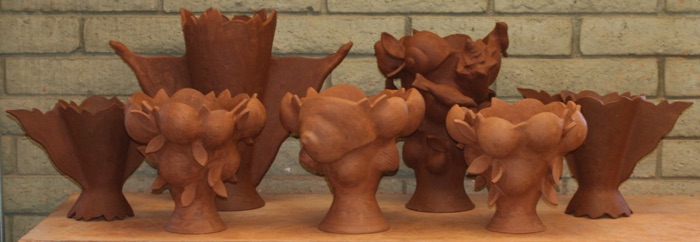Text
February 2011 Newsletter
Indigo Street Pottery Newsletter
In this Issue
1. Indigo Street Pottery Calendar
2. 10th Annual ASU Ceramic Studio Tour
3. Contemporary Forum 2011 Art Auction
4. Takashi Nakazato coming to the Mesa Arts Center in February
-
5.Indigo Street Pottery Garden Notes
Welcome to our monthly newsletter! It is part of our website indigostreetpottery.com , which you can browse from this page if you click on the subjects in the header. We write here about our studio, arts events, projects, studios of our friends, garden musings, and whatever else strikes our fancy. Hope you enjoy it!
February 19, 2011: Contemporary Forum’s A Night of Stars 2011 Annual Dinner Art Auction, Phoenix Art Museum contemporaryforum.org
February 20, 2011: Art on the Vine, Oregon College of Art and Craft, Portland, Oregon http://www.ocac.edu
February 26 & 27, 2011: ASU Art Museum Ceramic Research Center’s 10th Annual Ceramic Studio Tour. Indigo Street Pottery is host site #15 with Jeff, Farraday, and guest artists Les Lawrence, Jaye Lawrence, and Sherrie Zeitlin. asuartmuseum.asu.edu/ceramicsresearchcenter
March 11- May 8, 2011: Spring Vase Invitational, Artisan Gallery, Northampton, Massachusetts http://www.theartisangallery.com
March 29 - April 1, 2011: La Mesa, NCECA 2011, NCECA Gallery Expo, Santa Fe Clay, Tampa, Florida http://santafeclay.com
May 2012: Jeff Reich and Farraday Newsome, 2-person exhibition, Plinth Gallery, Denver, Colorado http://plinthgallery.com/
Takashi Nakazato, one of the most celebrated of contemporary Japanese potters, and his assistant Kazu Oba, will be working as artists-in-residence at the Mesa Arts Center in Mesa, Arizona for the month of February, 2011. Takashi Nakazato is a 13th generation potter and the 5th son of Japanese National Treasure, Taroemon Nakazato from Karatsu on Kyusyu Island. Mr. Nakazato is well-known for his yakishime (high fired unglazed) ware. For more information about Mr. Nakazato, please see the extended biography in the January 2011 Newsletter.
In additon to Mr. Nakazato’s month-long residency, Jeff Reich, head of Ceramics at the Mesa Arts Center, has organized a workshop that Mr. Nakazato will conduct at the Mesa Arts Center on Sunday, February 13, 2011. A reception for workshop attendees and guests will follow that includes a traditional Japanese tea ceremony presented by the Japanese Club of Arizona and traditional Japanese bamboo flute music performed by Bobby Avstreih.
For more information go to:
1 Indigo Street Pottery Calendar
2 10th Annual ASU Ceramic Studio Tour
3 Contemporary Forum of the Phoenix Art Museum
2011 Dinner Art Auction
4 Indigo Street Pottery Garden Notes
4 Takashi Nakazato Coming to the Mesa Arts Center, Arizona
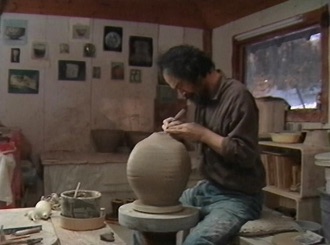
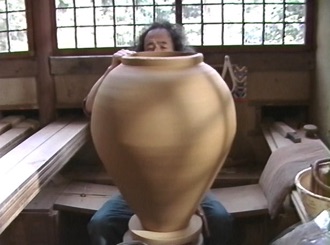
This will be Indigo Street Pottery’s 9th year as a host site for this annual, free self-guided ceramic studio tour. We are site #15 this year. The tour is sponsored by the Arizona State University Art Museum Ceramic Research Center.
When: February 26 & 27, 2011, 10am - 4pm each day
Where: Studio ceramists across the wider Phoenix metropolitan area open their studios to hundreds of visitors for the 2-day tour. In addition our work, Indigo Street Pottery studio will host guest artists Les Lawrence, Jaye Lawrence, and Sherrie Zeitlin this year. Our site’s address is 6931 E. Indigo St., Mesa, AZ 85207.
Along with seeing plenty of finished work for sale by the various participating artists, there are scheduled demonstrations to gain insight into how the art is made. Complete information on all sites and artists, as well as a map and locations of all sites and schedule of demonstrations can be found on Arizona State University Art Museum’s website: asuartmuseum.asu.edu/ceramicsresearchcenter
You can also visit the Ceramic Studio Tour’s new Facebook page: http://www.facebook.com/pages/Ceramics-Studio-Tour/274600532039?ref=ts
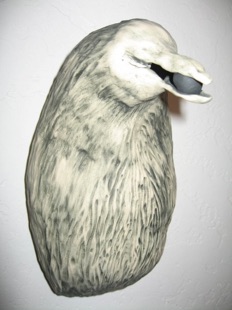

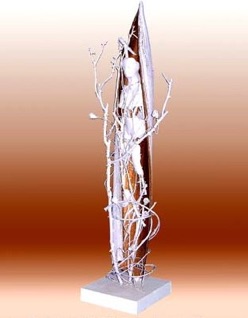
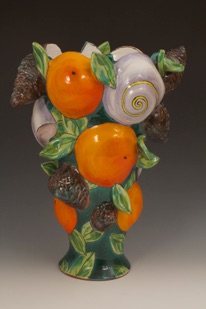

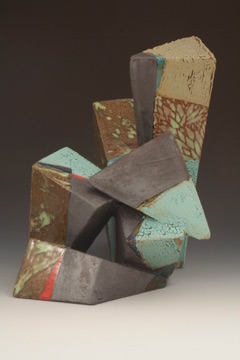
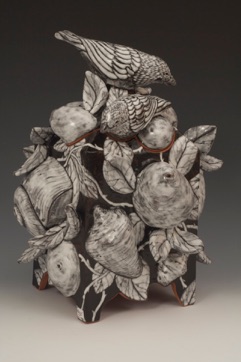
The Contemporary Forum is an auxiliary group of the Phoenix Art Museum dedicated to raising money for museum acquisitions, contemporary exhibitions, support for artists, U.S. and foreign travel, gallery and salon events, architectural tours, and arts lectures and films. Their glamorous annual Art Auction & Dinner at the Phoenix Art Museum is a major fundraiser for this worthy group. This year’s theme is A Night of Stars. The event takes place Saturday evening February 19, 2011. For more info and tickets: contemporaryforum.org
Jeff and Farraday donate work for this Phoenix art Museum fundraiser every year. Last year Jeff participated in the live auction with his sculpture Winter Thorns, and Farraday was part of the silent auction with her Promise of Moonlight lidded box. This year we will have centerpiece work on the dinner tables that will be for sale as an additional part of the fundraiser. The other four artists who will have artwork for sale on the auction dinner tables will be Linda Kilgore, Nicholas Bernard, Sam Chung, and Greg Beals.
Les Lawrence, thin-walled hand-built porcelain teapot, approx. 9 x 11 x 4”
Jaye Lawrence, Standing Figure #1, clay, wood, wire and paint, 18 x 5 x 8”, 2001
Sherrie Zeitlin, Standing Figure #1, clay, wood, wire and paint, 18 x 5 x 8”, 2001
Jeff Reich, Erratic, glazed stoneware sculpture with welded steel base, 65” h, 2010
Farraday Newsome, Dark Green Vase with Oranges, Shells and Pinecones, 15 x 10.5 x 10.5”, 2010
5 Indigo Street Pottery Wildlife Note



The Gilded Flicker, which we see regularly in our yard and in our largest saguaro, is listed by the Arizona Important Birds (IBA) program as an Arizona Watchlist “red species”, which is essentially a list of globally threatened birds of Highest National Concern that occur in the United States.
The U. S. Fish and Wildlife Service listed Gilded Flicker as a Conservation Concern in 2002 and as a Focal Species in 2005. No specific conservation plans serve the Gilded Flicker, but the conservation of other desert species and environments probably benefit it. Also, the conservation of this woodpecker is important to other species, like the Ferruginous Pygmy-Owl and the Elf Owl (a Watchlist Species), which nest in the holes that the Gilded Flicker excavates.
The Gilded Flicker is closely related to the Northern Flicker and can be distinguished by its golden-yellow underwings when it is flying. The Northern Flicker has red underwings. Also, the Gilded Flicker nests in saguaros, whereas the Northern Flicker usually nests in riparian area trees.
The loss of nesting habitat and suitable nest cavities in the Sonoran Desert are the primary threats to the Gilded Flicker, especially in Arizona, where human population growth is intense. The Gilded Flicker's range is already severely restricted. Preserving the Sonoran Desert and protecting its large cacti are the two most important conservation issues for the flicker. The Gilded Flicker needs mature stands of cactus associated with adjacent woodland or brushland along seasonal water courses. On average, giant Saguaros do not flower until 55 years old, when they are about 8 feet tall, and they do not begin to branch until they are 50-100 years old.
This is a beautiful bird and we feel so fortunate to have it as a local resident. We hope this bird can continue to breed in our area and we try to do our part locally with our saguaros and native wildscaped habitat.
Note the golden-yellow underwings, distinguishing the Gilded Flicker from the Northern Flicker, which has red underwings.

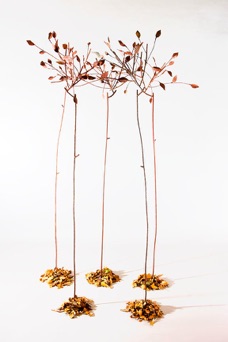
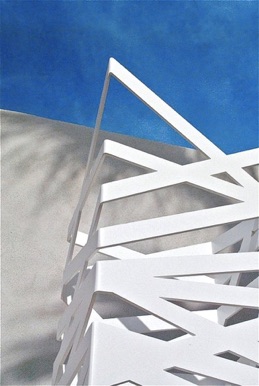
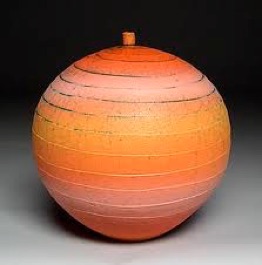
This is a photo of the Clevenger House in what is now Boyce Thompson Arboretum, just west of Superior, Arizona. The Clevenger family built this rock house in 1915 into the cliff along Queen Creek. What really interested us is that the Clevengers planted and maintained a fruit orchard in the riparian zone along the creek, creating a mixed forest of Sonoran desert native trees and the various non-native fruit trees. They sold their produce to local miners and then sometime in the early 20's they just left. Not much else is known about them.
We were taken by a sense of discovery and delight as we walked along the creek zone and came across various citrus, as well as apple, loquat, fig, pecan and jujube trees growing among the cottonwoods, paloverdes, mesquites and other native trees and shrubs.
We have incorporated over twenty non-native fruit trees into the native wildscaping in our own Sonoran yard this year at Indigo Street Pottery, inspired by historical examples like this.
Jeff Reich, Desert Erratic, stoneware, 12.5 x 11 x 9”, 2010
Farraday Newsome, Promise of Moonlight, hand-built lidded box, glazed terra cotta, 13 x 10 x 10”, 2010
Linda Kilgore, Cinque Alberi con le Foglie Francese
Five trees with French Leaves
each tree approximately 74" x 25" x 15"
painted steel and natural French leaves
(this is a detail of the twenty tree installation)
Sam Chung, Cloud Pot 2, hand-built porcelain with china paint, 2010
Nicholas Bernard, Spiral Orb, thrown earthenware with colored engobes, 2010
Greg Beals, Bindings VIII, featuring hand-fabricated, intertwining strips of metal that create shadows, is proposed for the Santa Fe Municipal Airport

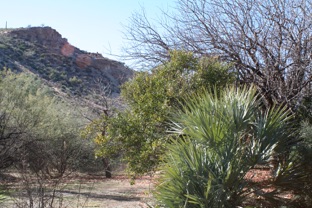
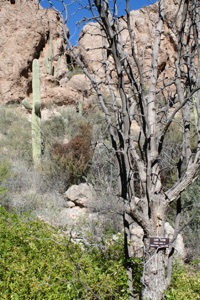



Clevenger House Fruit Trees, Boyce Thompson Arboretum, Superior, Arizona
Below, top row, left to right:
1. Jeff between two citrus trees, with saguaros and the creekside cliffs behind.
-
2.An evergreen orange tree at center right, behind a palm.
Below, bottom row, left to right:
-
3.A deciduous fig tree on the right with a Palo Verde tree on the left.
-
4.A deciduous apple tree in the foreground with a citrus behind it, then a tall deciduous pecan tree in the background.
-
5.A deciduous jujube tree (Lang-Lang variety) in foreground, saguaro cactus and cliffs behind.
